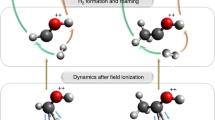Abstract
The postulated spur model is scrutinized by reference to μ SR and MSR data in a variety of media. Specific arguments are given against the spur model when applied to: water and aqueous solutions of electrom scavengers; low dielectric media such as hydrocarbons and liquid argon-and particularly the contrast between the muonium yield and the radiolysis free-ion yield; CCl4 and its mixtures with hydrocarbons; and the absence of an effect of an external electric field. Comments are made regarding the timescale of muonium formation and on important comparisons with positronium formation. It is suggested that an “expanding track” model may account for the missing polarization which is observed in liquids but not in solids.
Similar content being viewed by others
References
P. W. Percival, E. Roduner and H. Fischer, in “Positronium and Muonium Chemistry” Editor H. J. Ache, Adv. Chem. Series175, (1979) 335.
P. W. Percival, E. Roduner and H. Fischer, Chem. Phys.32 (1978) 353.
O. E. Mögensen, J. Chem. Phys.60, (1974) 998.
J. L. Magee and A. Chatterjee, Radiat. Phys. Chem.15, (1980) 125.
J. H. Brewer, K. M. Crowe, F. N. Gygax and A. Schenck, in “Muon Physics”, edited by V. W. Hughes and C. S. Wu, Academic Press, New York 1975, p. 3. See for example: (a) G. Duplatre, A. G. Maddock, J. Ch. Abbe and A.
Haessler, Chem. Phys.28, (1978) 433;
G. Wikander, Chem. Phys.38, (1979) 181.
A. Mozumder, in “Advances in Radiation Chemistry, Vol. 1” edited by M. Burton and J. L. Magee, Wiley, New York 1969, p. 1.
M. Anbar, M. Bambenek and A. B. Ross, NSRDS-NBS 43 (1973).
D. C. Walker, Y. C. Jean and D. G. Fleming, J. Chem. Phys.72, (1980) 2902.
D. C. Walker, Y. C. Jean and D. G. Fleming, J. Chem. Phys.70, (1979) 4534.
Y. Ito, B. W. Ng, Y. C. Jean and D. C. Walker (in press).
R. F. Kiefl, J. B. Warren, G. M. Marshall, C. J. Oram and C. W. Clawson (submitted for publication).
A. O. Allen, NSRDS-NBS 57 (1976).
A. O. Allen, NSRDS-NBS 58 (1976).
O. E. Mögensen, Appl. Phys.6, (1975) 315.
Y. Ito, B. W. Ng, Y. C. Jean and D. C. Walker, later paper in this volume.
D. G. Fleming, D. M. Garner, L. C. Vaz, D. C. Walker, J. H. Brewer and K. M. Crowe, in “Positronium and Muonium Chemistry” edited by H. J. Ache, Adv. Chem. Series175, (1979) 279.
B. W. Ng, Y. C. Jean, Y. Ito and D. C. Walker (to be published).
P. W. Percival, J. Chem. Phys.72, (1980) 2901.
P. W. Percival, Radiochimica Acta26, (1979) 1.
Y. C. Jean, J. H. Brewer, D. G. Fleming and D. C. Walker, Chem. Phys. Lett.,50, (1978) 125.
Author information
Authors and Affiliations
Rights and permissions
About this article
Cite this article
Walker, D.C. Arguments against a spur model for muonium formation. Hyperfine Interact 8, 329–335 (1981). https://doi.org/10.1007/BF01037489
Issue Date:
DOI: https://doi.org/10.1007/BF01037489




